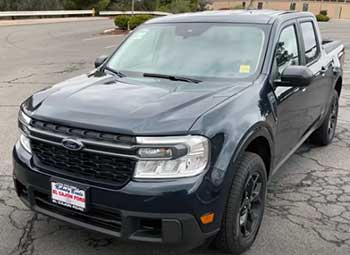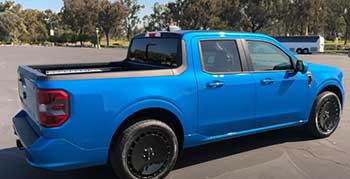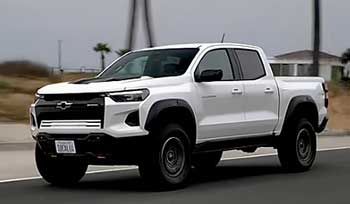
I’ve always been fascinated by pickup trucks—their rugged charm, versatility, and ability to tackle both work and play.
When I set out to compare the 2025 Ford Maverick and Chevrolet Colorado, my goal was to uncover which truck best suits real-world needs like mine and yours.
Whether you’re hauling gear for a weekend adventure or navigating city streets with a baby seat in tow, this article explores the strengths and weaknesses of these two compact and midsize contenders.
Let’s break down their features, performance, and value to help you decide which truck fits your lifestyle.
Comparison Table
| Feature | Ford Maverick | Chevrolet Colorado |
|---|---|---|
| Starting MSRP | $29,500 | $33,595 |
| Fuel Economy (City/Highway) | 42/35 MPG (Hybrid) | 20/24 MPG |
| Towing Capacity | Up to 4,000 lbs | Up to 7,700 lbs |
| Payload Capacity | 1,500 lbs | 1,710 lbs |
| Bed Length | 54.4 inches | 61.7 inches |
| Base Engine | 2.5L Hybrid (191 hp) | 2.7L Turbo (237 hp) |
| Infotainment Screen | 13.2-inch touchscreen | 11.3-inch touchscreen |
| Ground Clearance | 9.4 inches (Tremor) | 12.2 inches (ZR2 Bison) |
| Safety Rating (NHTSA) | 4/5 stars | 4/5 stars |
| Warranty | 36 months/60,000 km | 36 months/60,000 km |
My Experience With the Ford Maverick
When I first slid behind the wheel of the 2025 Ford Maverick, it felt less like a traditional pickup and more like a nimble SUV with a bed. Its compact size—smaller than most midsize trucks—made it a breeze to maneuver through crowded city streets.
I tested the hybrid model, which pairs a 2.5L Atkinson-cycle engine with an electric motor for a combined 191 horsepower. The smooth ride and car-like handling surprised me, especially when weaving through traffic or parking in tight spots. The interior felt modern, with a 13.2-inch touchscreen stealing the show. Wireless Apple CarPlay and Android Auto made connecting my phone effortless, and the available Bang & Olufsen audio system turned my commute into a mini concert.
On a weekend trip, I loaded the Maverick’s 4.5-foot bed with camping gear and found its clever storage solutions—like under-seat compartments and a 110-volt outlet in the bed—genuinely useful. However, the bed’s smaller size and 1,500-pound payload capacity felt limiting compared to larger trucks.
I also noticed the hybrid’s 4,000-pound towing capacity was adequate for a small trailer but not ideal for heavier loads. The Maverick’s Tremor trim, with 9.4 inches of ground clearance, handled light off-road trails decently, but it’s no rock crawler. Overall, it’s a truck built for urban dwellers who want efficiency and versatility without the bulk of a full-size pickup.
My Experience With the Chevrolet Colorado
Driving the 2025 Chevrolet Colorado was a different beast altogether. As a midsize truck, it felt more substantial, with a commanding presence on the road. I tested the Z71 trim, powered by a 2.7L turbocharged engine pumping out 237 horsepower. The Colorado’s acceleration was punchy, and its 7,700-pound towing capacity made it clear this truck is built for serious work. I towed a small boat during my test, and the Colorado handled it with ease, thanks to its higher torque output compared to the Maverick.
The Colorado’s 5-foot-2-inch bed offered more cargo space, and its 1,710-pound payload capacity let me haul heavier loads without breaking a sweat. Off-road, the ZR2 Bison trim shone with 12.2 inches of ground clearance and all-terrain tires, making it a better choice for rugged adventures.
The interior was solid but less flashy, with an 11.3-inch touchscreen and Google Built-In features. However, the ride felt rougher than the Maverick’s, especially in city settings, and the fuel economy (20 MPG city, 24 MPG highway) was a noticeable drawback. The Colorado is a workhorse, but its size and thirst for fuel make it less practical for daily urban commutes.
Pros Of the Ford Maverick

- Fuel Efficiency: The Maverick’s hybrid powertrain delivers an impressive 42 MPG city and 35 MPG highway, making it a standout for budget-conscious drivers like me who cringe at gas station prices.
- Affordable Price: Starting at $29,500, it’s nearly $4,000 cheaper than the Colorado, offering great value for a versatile truck.
- Compact Size: Its smaller footprint makes parking and navigating tight spaces a breeze, perfect for city life.
- Tech-Savvy Interior: The 13.2-inch touchscreen, wireless smartphone connectivity, and optional Bang & Olufsen audio system create a premium feel.
- Clever Storage: Features like under-seat compartments and a 110-volt outlet in the bed add practical utility for everyday tasks.
- Smooth Ride: Built on the same platform as the Ford Escape, the Maverick handles like a car, offering a comfortable ride for daily commutes.
- Hybrid Option: The standard hybrid engine is a game-changer, blending efficiency with decent power for light-duty needs.
The Maverick’s efficiency and affordability make it a compelling choice for someone like me, who needs a truck for light hauling and urban driving. Its tech features and clever design make it feel modern and user-friendly, though it sacrifices some capability for its compact size.
Cons Of the Ford Maverick
- Limited Towing Capacity: With a max towing of 4,000 pounds, it struggles with heavier loads, which was noticeable when I considered towing a larger trailer.
- Smaller Bed Size: The 4.5-foot bed is shorter than the Colorado’s, limiting cargo space for bulkier items like furniture.
- Lower Payload Capacity: At 1,500 pounds, it can’t handle as much weight as the Colorado, which I found restrictive for home renovation projects.
- Not Ideal for Off-Roading: Even with the Tremor package, the 9.4-inch ground clearance pales compared to the Colorado’s off-road prowess.
- Base Model Sparsity: The base XL trim feels bare-bones, lacking some creature comforts like a telescoping steering wheel, which I missed during long drives.
- Rear Seat Space: The crew cab’s rear seats are cramped, especially for fitting a rear-facing child seat, which was a concern for my family needs.
- Limited Availability: When I looked, some dealers charged over MSRP due to high demand, making it tricky to snag a good deal.
While the Maverick excels in efficiency and urban usability, its limitations in towing, payload, and off-road capability make it less versatile for heavy-duty tasks or rugged adventures.
Pros Of the Chevrolet Colorado
- Superior Towing Capacity: With up to 7,700 pounds of towing, it easily handled a boat I towed, outclassing the Maverick for heavy-duty tasks.
- Larger Bed Size: The 5-foot-2-inch bed offers more cargo space, perfect for hauling larger items like appliances or camping gear.
- Higher Payload Capacity: At 1,710 pounds, it can carry heavier loads, which I found useful for construction materials.
- Off-Road Capability: The ZR2 Bison trim, with 12.2 inches of ground clearance and all-terrain tires, tackled rough trails with confidence.
- Powerful Engine Options: The 2.7L turbo engine (237 hp) and optional high-output version (310 hp) deliver robust performance for work and play.
- Spacious Interior: The crew cab offers more head- and legroom, making it comfortable for taller passengers or long drives.
- Off-Road Trims: With three off-road-oriented trims (Trail Boss, ZR2, ZR2 Bison), it’s a top pick for adventure seekers.
The Colorado’s raw power and capability make it a standout for those who need a truck for towing, hauling, or off-roading, offering a more traditional pickup experience.
Also read: My Thoughts on Ford Edge Vs. Hyundai Tucson.
Cons Of the Chevrolet Colorado

- Poor Fuel Economy: At 20 MPG city and 24 MPG highway, it’s far less efficient than the Maverick, which hit my wallet harder during testing.
- Higher Price: Starting at $33,595, it’s pricier than the Maverick, which might stretch budgets for cost-conscious buyers like me.
- Rougher Ride: The midsize frame and truck-like suspension make it less comfortable in urban settings compared to the Maverick’s smoother ride.
- Smaller Infotainment Screen: The 11.3-inch touchscreen feels less impressive than the Maverick’s 13.2-inch display, with slightly clunkier menus.
- Bulky Size: Its larger dimensions make parking in tight city spaces trickier, which I noticed in busy lots.
- Base Model Quality: The Work Truck trim feels cheap, with basic plastics and missing features like a telescoping steering wheel, as I read in user feedback.
- No Hybrid Option: Unlike the Maverick, it lacks a hybrid powertrain, limiting its appeal for eco-conscious drivers.
The Colorado’s workhorse nature comes at the cost of efficiency and urban friendliness, making it less ideal for daily city commutes or budget-focused buyers.
Maintenance Tips For the Ford Maverick
- Regular Oil Changes: I schedule oil changes every 7,500 miles or six months for the hybrid, and every 5,000 miles for the EcoBoost engine, to keep the powertrain running smoothly.
- Tire Rotations: Rotating tires every 6,000 miles ensures even wear, especially since I noticed the Maverick’s front-wheel-drive setup can stress front tires.
- Battery Checks: The hybrid’s battery needs periodic checks at a dealership to maintain efficiency; I do this annually to avoid surprises.
- Brake Inspections: With city driving, I inspect brakes every 12,000 miles, as the hybrid’s regenerative braking can reduce wear but not eliminate it.
- Air Filter Replacement: I replace the cabin and engine air filters every 15,000 miles to maintain air quality and fuel efficiency, especially in dusty areas.
- Software Updates: The SYNC 4 system benefits from regular updates, which I get done at service visits to keep the infotainment glitch-free.
- Bed Maintenance: I clean and inspect the bed’s tie-downs and outlets regularly to prevent rust or damage from cargo, especially after hauling wet gear.
Maintaining the Maverick is straightforward, but its hybrid system requires extra attention to battery health and software updates to maximize efficiency and longevity.
Maintenance Tips For the Chevrolet Colorado
- Engine Maintenance: I stick to oil changes every 5,000 miles for the turbocharged engine to ensure optimal performance, especially under heavy towing loads.
- Tire Care: Rotating tires every 6,000 miles and checking alignment is key, as I found the Colorado’s off-road trims wear tires faster on rugged terrain.
- Cooling System Checks: I inspect the radiator and coolant levels every 10,000 miles, as towing can strain the cooling system.
- Brake Servicing: Heavy towing means I check brakes every 10,000 miles to catch wear early, especially on off-road trims like the ZR2.
- Fluid Inspections: Transmission and differential fluids need checking every 30,000 miles, particularly if I’m using the truck for frequent hauling.
- Suspension Maintenance: Off-road driving requires inspecting shocks and struts every 15,000 miles to maintain the Colorado’s rugged capability.
- Infotainment Updates: I ensure the Google Built-In system gets software updates during service visits to avoid connectivity issues with Apple CarPlay.
The Colorado’s robust build demands diligent maintenance, especially for towing and off-roading, to keep its performance and durability intact.
Read more: My Thoughts on GMC Terrain Vs. Ford Escape.
Comparison With Other Brands
- Ford Maverick vs. Hyundai Santa Cruz: The Maverick’s hybrid option gives it better fuel economy (42 MPG city vs. Santa Cruz’s 22 MPG), but the Santa Cruz offers a slightly larger bed (52 inches) and more upscale interior finishes.
- Ford Maverick vs. Honda Ridgeline: The Ridgeline’s unibody construction matches the Maverick’s smooth ride, but its higher starting price ($39,000) and lower fuel economy (18 MPG city) make the Maverick a better value.
- Ford Maverick vs. Toyota Tacoma: The Tacoma’s starting price ($31,500) is closer to the Maverick’s, but its fuel economy (20 MPG city) and rougher ride make it less urban-friendly.
- Chevrolet Colorado vs. Ford Ranger: The Ranger’s towing capacity (7,500 lbs) is close to the Colorado’s, but its smaller bed (48 inches) and higher price ($33,000) give the Colorado an edge for utility.
- Chevrolet Colorado vs. Toyota Tacoma: The Colorado’s larger bed and higher towing capacity outshine the Tacoma’s, though the Tacoma’s reputation for reliability is a strong contender.
- Chevrolet Colorado vs. GMC Canyon: The Canyon shares the Colorado’s platform, but its premium trims (like Denali) push prices higher ($40,000), making the Colorado a better value.
- Chevrolet Colorado vs. Nissan Frontier: The Frontier’s towing (6,720 lbs) and payload (1,610 lbs) are slightly lower than the Colorado’s, and its dated interior feels less modern.
Both trucks face stiff competition, but the Maverick’s efficiency and price make it unique, while the Colorado’s capability aligns it with traditional midsize trucks.
Frequently Asked Questions (FAQ)
No, the Chevy Colorado is larger, with a longer bed (61.7 inches vs. 54.4 inches) and wider dimensions, making it a midsize truck compared to the compact Maverick.
The Chevy Colorado is not being discontinued; it remains in production for 2025 with updated trims and features, competing strongly in the midsize truck segment.
The Maverick compares closely to the Hyundai Santa Cruz and Honda Ridgeline due to its compact size and unibody construction, unlike traditional midsize trucks.
Yes, the Maverick is worth buying for its fuel efficiency, low price, and urban-friendly design, though it’s less suited for heavy towing or off-roading.
Conclusion: For Ford Maverick and Chevrolet Colorado
Choosing between the Ford Maverick and Chevrolet Colorado depends on your needs. If you’re like me, juggling city commutes and light hauling, the Maverick’s hybrid efficiency, compact size, and tech-savvy interior make it a fantastic pick.
Its affordability and car-like ride are hard to beat. But if you need a truck for towing, heavy loads, or off-road adventures, the Colorado’s power, larger bed, and rugged trims are your best bet. Test drive both to see which fits your lifestyle—whether it’s urban efficiency or workhorse grit, you can’t go wrong.

